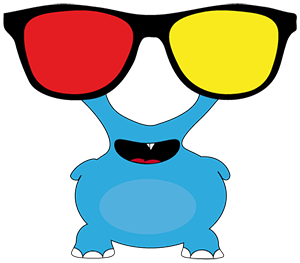Colored Spectacles: An Alien Point of View

Introduction
Light can be thought of as electromagnetic waves that travel through space with specific frequenciesand wavelengths. The light in the visible spectrum ranges from red to violet, like the colors of a rainbow. White light can be separated into the colors of the visible spectrum in passing through an object such as a prism or a water droplet. When the light passes through the object, each color is spread into a different angle so we are capable of seeing the colors. Wavelengths such as microwaves, radio waves, infrared, x-rays, and gamma rays are not visible to human beings. Remote sensors assist us in detecting these invisible electromagnetic wavelengths.
National Science Education Standards Addressed
- Abilities Necessary to DO SCIENTIFIC INQUIRY/UNDERSTANDING About SCIENTIFIC INQUIRY
- PROPERTIES and Changes of Properties in MATTER/STRUCTURE and FUNCTION in living Systems
- ABIliTIES of Technological Design/UNDERSTANDING About Science and Technology
- PERSONAL HEALTH/Science and Technology in SOCIETY
Materials Needed
- Six 35 mm x 130 mm pieces of heavy card stock with two 20 x 20 mm windows
- tape
- hole punch
- transparency squares (two each of clear, red, green, blue, yellow, and orange cut in 25 x 25 mm squares)
- two pieces of yarn 200 mm long
- one covered tray with objects of varying colors
- one sheet of white copy paper
- light socket
- light bulb
Investigation
Take six pieces of the heavy card stock. Fold each end over 25 mm. Secure the flap with tape. Punch a hole in the middle of each folded, taped end. Tie one end of a strip of yarn to each end of the glasses. Make six pair of glasses, one each with red, green, blue, and clear lenses. Take one sheet of white copy paper and one covered tray to the table. Tape the white paper to the table. Place one experimental object at a time on the sheet. Assign one group member to be the recorder for your group. Tape the clear lenses to your glasses, observe each object, and describe what you see. Replace the clear lenses with red, green, and blue ones. Observe each object through each color. Record what you see.
Inquiry
- What are the similarities and differences of viewing each object through each type of lens? Develop asystematic way of describing and recording your results. Post your experimental results in the classroom.
- What might have happened if no white sheet was used? Select three other colors and determine how theresults may have been affected. Develop a systematic way of describing and recording your results.
- What happens to the experimental results if orange or yellow lenses are used? Would the experimentalresults be affected enough to justify the cost of adding orange or yellow lenses to the experiment? Why or why not?
- Take your glasses outside and look around. What lenses make clouds most easily visible compared withthe surrounding blue sky? What about trees or rocks?
- Why do scientists refer to red, blue, and green as primary colors? Why do artists refer to red, blue, andyellow as primary colors?
Activity
- Use the internet to investigate remote sensing, particularly passive remote sensing. How do theexperimental results relate to passive remote sensing with multispectral imaging?
- Use your experimental results to enhance the story line of your science fiction short story.
- Did anyone in your group see the colors of the objects differently from the majority of the group? Whichcolor(s) were involved? Why do some people see colors differently? Is this primarily a male or female trait?
- Overlap the red, blue, and green spectacle lenses in layers so that there is some overlap of all threecolors. There should also be some overlap in two-color combinations for each possible color pair. Some of the initial color should remain where no overlapping occurs. Shine the light from the bulb through them. What colors do you see in each area? Why do you see these colors? Prepare a chart detailing your results.
- Use the internet or books to learn about infrared and ultraviolet light and how such invisible light isuseful in remote sensing. What kind of light does your TV remote control use? Look at the light beam by pointing the remote control directly at a home video camera and pressing a button. Why does the light flash?